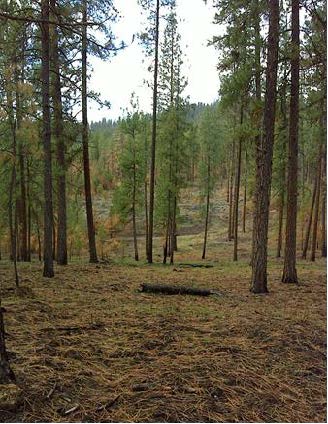You are viewing ARCHIVED content published online before January 20, 2025. Please note that this content is NOT UPDATED, and links may not work. Additionally, any previously issued diversity, equity, inclusion or gender-related guidance on this webpage should be considered rescinded.
The Carpenter Road Fire started August 14 on a hot, dry, windy day when resources to put it out quickly were critically low. Wind and dry conditions forced the fire to jump the northern Reservation boundary onto lands administered by the Bureau of Land Management, Washington State Department of Natural Resources, and the Stevens County Fire Protection District. After a month of hard work the fire was contained September 18. It burned, 21,000 acres of the Spokane Reservation. An estimated 56 million board feet of commercial timber, valued at over $14 million burned.
From 2003 to 2015, the Spokane Tribe implemented over 6,000 acres of fuels reduction treatments within the Carpenter Road Fire perimeter. These treatments, which include thinning, chipping, pruning, mastication, and lop and scatter were strategically placed to break up vegetation and reduce wildfire risk, particularly in wildland urban interface areas.

Fire impacts to vegetation and soils were minimal. Note immediate vigorous natural herbaceous response.
One such treated area was Nixon Rock, a 2,882 acre prescribed fire treatment located near the southwest edge of the Carpenter Road Fire area, approximately eight miles northwest of the community of Wellpinit. Using a combination of commercial harvesting, pre-commercial thinning and prescribed fire, the Tribe manages the site for timber productivity.
During the Carpenter Road Fire, the Nixon Rock fuels treatment was designed to enhance opportunities to use the Sand Creek Road and another rural road as a holding point. It was also used to minimize damages to timber and wildlife habitat. There was an additional opportunity to use the treatment area as to anchor a burnout operation. Due to minimal fire behavior, only a few resources were needed to hold this area. This allowed other critical resources to focus efforts where the need was greater.
As a result of this proactive fuels treatment, very little commercial timber mortality occurred. Areas outside the treatment experienced more severe fire effects, (9% within fuels treatments versus 17% outside treatments) and a 183% higher incidence of extreme tree mortality (6% versus 17%).
These mortality figures were used to estimate the avoided costs that would have been incurred had the fuels treatments not been implemented. Over eight million board feet of timber valued at over $2.1 million was preserved as a result fuels treatment areas. If associated additional reforestation costs are factored in, the total savings realized approaches $2.5 million. Additional costs that were avoided include health costs due to reduced smoke emissions, reduced soil erosion due to the lower fire intensity levels that did not over-cook the forest soils and an overall cost savings to public and firefighter safety as a result of having no injuries in the treated area.
For Immediate Release: May 1, 2016


